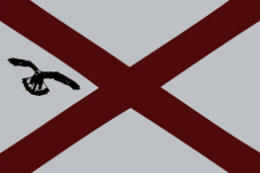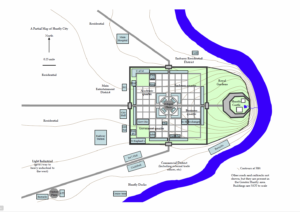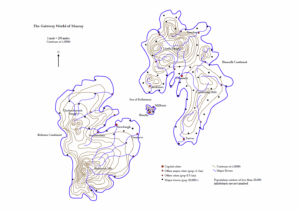Murray
 The Gateway World of Murray
The Gateway World of Murray
- The World of Murray
- The Murray Trading Shadows
- Life in Murray
- Government, Military and Security
- The Ruling Family
- Other Members of the de Lacy Family on Murray
Overview
Murray is the Sable gateway world on the Ouside, and serves as the trading link between the Sable Shadows and the wider multiverse. It was founded by King Robert on 21 December SY105, in tandem with the Reich world of Sanguine. When first founded, it was ruled by Prince James, as Regent for his grandfather, King Robert. Since October SY106, however, the Regent has been Emily de Lacy. It is a ruled as Constitutional Regency: the government governs, and the Regent oversees and makes sure that the interests of the King of Sable, from whom she holds her position, are represented.
The world comprises a pair of continents, each of almost a million square miles in area. Of these, Hearadh continent is more temperate, getting actively cool to the north; while Belenus , to the south, is somewhat warmer. Despite the land area, the population density is very low, at a little under 150m all told, plus off-world visitors. Between them is the Sea of Rothiemay, in which is an island about one hundred miles across, where the capital of Huntly is situated.
Hearadh continent, capital Cromarty (pop 5m), is where the majority of the native population of Murray lives, numbering about 100m people. To the north of the continent is the Lliath Mountain range, which reaches to around 10,000ft. There is also another, extensive set of high hills to the south, the Carlincraig Hills. From the highlands, forested foothills roll outwards, until they finally give way to managed forests and agricultural land. Rivers criss-cross the continent, and the major cities are all on such rivers or confluences of the rivers, some distance from the coast or above 1,000ft. The entire coastland is made up of cliffs of varying heights from 50-300ft, a geographic change in the wake of the Shadow-storm generated tsunami that devastated the world in the mid-SY130s and reduced the population by almost half. The rivers have cut deep gorges in the cliffs to drain into the sea. In addition, the fishing harbours, which mostly border the Sea of Rothiemay, are often now in cliff-walled bays, and require steps to get down to the sea. In these bays, elevator systems have been put in place to lift people and cargo from the sea to the villages above. Although there are a nomadic tribes and clans living at altitude, as well as hill farmers and much of the forestry industry, the majority of the population lives closer to sea level – probably 75% of them at 1,500ft or less above sea level.
Belenus continent, capital Newburgh (pop 3m), is the primary centre of trade with a number of other worlds and nations, as well as the Inside Commonwealth, although most of the trading partners also have either offices or embassies in Huntly itself. The total population of the continent is around 45m plus visitors. Being somewhat further south than Hearadh, the climate on Belenus is significantly warmer. The Clashindarroch range is to the north of the continent, but only rises to a little over 6,000ft, and there is hill farming and forestry most of the way to the peaks. The Badenoch mountain range is to the south of the continent, and rises to nearly 12,000ft, with all the rivers from it draining either towards the Sea of Rothiemay, or to the south. To the west side, the mountains rise up very steeply from the coast, so there is only habitation on the coastal plains on that side. To the east of the mountains, the gradient is more shallow, sloping down towards the coastal plains near the Sea of Rothiemay, where the majority population live because the climate is more comfortable, albeit still warm. There is some farming, agriculture, viticulture and industry on Belenus, especially around Newburgh, Denmoss (pop 2.3m) and Inverkeithny (pop 2.2m), the three largest cities on the continent.
There is a mixture of agricultural and industrial economies. Industry is centred mainly around the larger cities on both continents, of which there are eight with populations in excess of two million people, plus the three capitals which are above 3m. Another dozen cities have populations in excess of one million people, and a further 25 or so are home to between 500,000 and 1m souls. There are also smaller cities and large towns which have a less-intensive industrial base, and there is still a strong fishing industry.
Rothiemay Island
 Rothiemay Island is located in the Sea of Rothiemay, between the two continents of Murray, and is the location of Huntly, Murray’s overall capital. In addition to Huntly itself (pop 3.5m), there is one other major population centre, Millburn (pop 750,000), and there are probably another 0.5-0.75m souls on the rest of the island, including a couple of larger towns, for a total island population of around 3.5-4m. The island is surrounded by cliffs on all sides, the most impressive, the Bailieshaven Cliffs, reaching 600ft. There are two major rivers on the island: the Garry and the Dronach, although there are also a number of rather smaller waterways scattered around the island. The River Garry rises at the Haugh of Glass, an impressive waterfall up in the Hatton Hills (at 2,400ft) to the north-west of the island, and eventually falls to sea level through Glen Garry, a steep-sided valley (almost a gorge) which cuts through the Bailieshaven Cliffs. It is navigable from the sea up to Hillbrae in the centre of the island, due to a complex lock system. The River Dronach rises in Glen Dronach, in the Annochie Uplands (which reach about 2,600ft), to the north-east of the island, although its course down to the sea is rather more gentle.
Rothiemay Island is located in the Sea of Rothiemay, between the two continents of Murray, and is the location of Huntly, Murray’s overall capital. In addition to Huntly itself (pop 3.5m), there is one other major population centre, Millburn (pop 750,000), and there are probably another 0.5-0.75m souls on the rest of the island, including a couple of larger towns, for a total island population of around 3.5-4m. The island is surrounded by cliffs on all sides, the most impressive, the Bailieshaven Cliffs, reaching 600ft. There are two major rivers on the island: the Garry and the Dronach, although there are also a number of rather smaller waterways scattered around the island. The River Garry rises at the Haugh of Glass, an impressive waterfall up in the Hatton Hills (at 2,400ft) to the north-west of the island, and eventually falls to sea level through Glen Garry, a steep-sided valley (almost a gorge) which cuts through the Bailieshaven Cliffs. It is navigable from the sea up to Hillbrae in the centre of the island, due to a complex lock system. The River Dronach rises in Glen Dronach, in the Annochie Uplands (which reach about 2,600ft), to the north-east of the island, although its course down to the sea is rather more gentle.
Rothiemay Island is split between industrial and agricultural production, and there are a number of fishing towns and villages around the island. Millburn is a primarily industrial city, with the agricultural centres being around Culdraine and Coynachie. There is forestry and hill farming on the slopes of the Annochie Uplands.
Huntly City
 The capital city of Murray is called Huntly, and is situated towards the south of the Rothiemay Island, nestling in a meander of the River Garry. Huntly itself comprises the walled Old City, which about a mile and a half square, and then the newer residential and industrial areas outside the walls in Greater Huntly, plus the Huntly Docks to the south. The Old City is built on the lower slopes of Castle Hill, which rises to about 400ft to the east, before dropping in high cliffs down to the river. If the whole area, including the residential and industrial suburbs, is taken into account, there are probably 2.5m souls in the Greater Huntly area.
The capital city of Murray is called Huntly, and is situated towards the south of the Rothiemay Island, nestling in a meander of the River Garry. Huntly itself comprises the walled Old City, which about a mile and a half square, and then the newer residential and industrial areas outside the walls in Greater Huntly, plus the Huntly Docks to the south. The Old City is built on the lower slopes of Castle Hill, which rises to about 400ft to the east, before dropping in high cliffs down to the river. If the whole area, including the residential and industrial suburbs, is taken into account, there are probably 2.5m souls in the Greater Huntly area.
The focus of the Old City is the Octagon Plaza, a large paved area with a road around the perimeter, where the four main thoroughfares in the Old City meet. The Plaza is used for meetings, concerts, fairs, etc, and is surrounded by the National Gallery, the Octagon Hotel, the Murray Museum, and the Huntly Concert Hall. Beyond the road are restaurants and shops, and bars, restaurants and shops also line the outermost road, remaining separated from the walls by more parkland. The only buildings which go right up to the walls are St Raphael’s Cathedral, and the Bishop’s Palace. Transport within the Old City is solely by carriage or omnibus, with other vehicles limited to the area outside the walls.
The remainder of the walled City is laid out in quarters in a block system, defined by the main thoroughfares, with parks in the corners. The south-western, or Government quarter is the location of Government House, the law courts, government offices, the cathedral and the Bishop’s Palace. Ministerial homes are also in the Government quarter, as is the HQ of the City Police (as distinct from the Greater Huntly Police). The University of Murray, Murray Mage School and the City School, plus some some residential property and a couple of other hotels, are in the north-western Academic quarter. Embassies and some of the residences attached to them are in the north-eastern Embassy quarter, with the other diplomatic residences and missions from off-world religions just outside the walls around the North Gate. The south-eastern or Business quarter primarily comprises offices, etc for the various Murray trading concerns which deal with the Commonwealth, plus the Stock, Metals and Commodities Exchanges, although again, there are a couple of hotels in this district plus the Museum of Trade and Industry, and the Gallery of Modern Art. The commercial district for off-world trade is through the South Gate, between the Old City and the River Garry.
Outside the walls is the metropolis of Greater Huntly. This outer city is split into a number of administrative areas with residential, commercial and industrial areas, and comprises the largest centre of population and population density on the world. There is a Huntly local council, which meets regularly at City Hall, outside the west wall of the Old City. That area also hosts a more extensive shopping and entertainment district, with hotels, theatres, cinemas, concert halls, nightclubs, casinos, etc. In addition, all visitors arriving by arcane means, including the ATS system arrive in the Visitors Plaza, to the south-west of the Commercial District, where their papers are checked before they are allowed into the rest of the city. Near the Visitors Plaza is the Huntly Army Barracks, along with the offices of the Murray SIS.
Huntly Castle, home of the Regent and her family, is situated atop the cliffs looking down on the River Garry, surrounded by a double curtain wall, plus an external fortification which joins to the walls of the Old City. Between the Old City and the castle, within the external wall, is public park known as Royal Gardens. The castle itself comprises a comfortable, fortified house and its outbuildings, and a central tower house keep, both stone built of local stone, with an area of private garden also enclosed within the inner curtain walls along with the barracks (which houses about 200 Royal Guard), other buildings, parade grounds and courtyards. There is also a spring which – possibly illogically – rises in a pond within the castle curtain walls, then forms a stream which flows through small arches in the cliff-side walls to the edge of the hill, before falling down the side of the cliffs into the river.
The small detachment of Sable Guard dragons assigned to Murray resides in the cliff face above the river.
Transport Around Murray
Transport on both continents is mostly by rail or road, although the rivers are used where navigable and there is coastal trade, especially on Belenus. The land transport network is more extensive on Hearadh, which has the higher population, spread more evenly across the continent than on Belenus. There is also a great deal of maritime traffic between the continents and with Rothiemay Island, and there are ATS stations in the eight largest cities as well as in the capital, Huntly. In addition, there is long-haul air traffic (by both jet and airship), which is priced somewhere between maritime and ATS transport. Airship company Murray Air Cruises Limited is a subsidiary of Sable Air Cruises.
The Secretary of the Murray Pilot’s Guild is Grand Pilot Deanna Woodrow, a Murray native. She joined the Guild fairly soon after Murray was founded, and has worked her way up through the ranks since.
The Murray Trading Shadows
 The Shadows in the two Veils immediately adjacent to Murray (in all directions, including up and down) are part of a Free Trade Association, dealing with each other and Murray itself. Certain of the Third Veil worlds are also part of the FTA. These worlds also have a defence treaty with Murray, in case anyone should decide to cause them problems. There are Murray military bases near the capitals of many of these. The tech level in these worlds varies from Rennaissance to near future (above 2022 equivalent).
The Shadows in the two Veils immediately adjacent to Murray (in all directions, including up and down) are part of a Free Trade Association, dealing with each other and Murray itself. Certain of the Third Veil worlds are also part of the FTA. These worlds also have a defence treaty with Murray, in case anyone should decide to cause them problems. There are Murray military bases near the capitals of many of these. The tech level in these worlds varies from Rennaissance to near future (above 2022 equivalent).
The ATS network spreads out to the Murray Trading Shadows. There is also maritime and air transport along the system of “Royal Ways”, which connects the worlds together, although these are more common and better used nearer to Murray itself.
The influence of Murray on the surrounding worlds then extends for another 16-17 Shadow Veils, gradually reducing the further out it gets, before finally bumping up against those lands which depend from Sanguine and Seconde.
Murray and Sanguine
Having been built at the same time, strong metaphysical links exist between Murray and its Reich counterpart, Sanguine. As a result, this has led to more commerce between the two than might have been expected, even before the Reich and Sable signed their Peace Treaty. In recent years, the fact that Regent Emily’s daughter Elanor is married to the second-most important individual on Sanguine, Jorge von Raeder, has served to make those links even closer.
Regent Emily and Reichsprotektor Kapler meet once a month, alternating locations betwen Huntly and Neumünster, echoing the regular meetings between King Robert, Kaiser Wilhelm and RFSS Delatz.
Murray and Seconde
With the Creation of Seconde on the Outside, in the same region of Shadow as Murray and Sanguine, Regent Emily made a point of making contact with her brother Andrew’s agents, Tyler and Howard Cameron. The three of them have regular meetings every couple of months, but never at the same time as she is meeting with Jürgen Kessler, due to the state of war that exists between the Technocracy and the Reich. She has, however, served as a peacekeeper between Sanguine and Seconde on more than one occasion.
